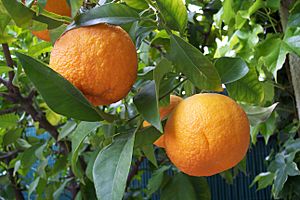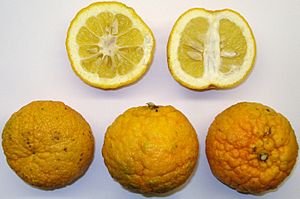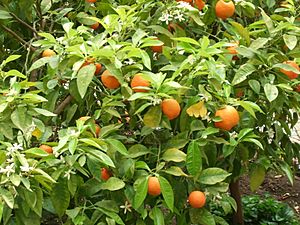Bitter orange facts for kids
Quick facts for kids Citrus aurantium |
|
|---|---|
 |
|
| Scientific classification | |
| Kingdom: | |
| (unranked): | |
| (unranked): | |
| (unranked): | |
| Order: | |
| Family: | |
| Genus: | |
| Binomial name | |
| Citrus × aurantium L., 1753
|
|
The bitter orange is a type of citrus tree and its fruit. It's also known as the Seville orange, sour orange, or marmalade orange. This tree is originally from Southeast Asia. Over time, people helped it spread to many other parts of the world. You can even find wild bitter orange trees growing near streams in Florida and the Bahamas. They were brought there from Spain, where they were first grown a lot by the Moors starting in the 10th century.
The bitter orange is a hybrid plant. This means it's a mix of two different citrus fruits: the pomelo (Citrus maxima) and the mandarin orange (Citrus reticulata). Many types of bitter orange are used for their special oils, called essential oils. These oils are found in perfume and are used to add flavor to foods or as a solvent. The Seville orange, a type of bitter orange, is especially famous for making marmalade.
Contents
Cooking with Bitter Orange
The Seville orange is a very tart, or sour, orange. It is now grown all around the Mediterranean Sea. It has a thick, bumpy skin. People love it for making marmalade because it has a lot of pectin. Pectin is a natural substance that helps jams and jellies set well. This means you get more marmalade from each fruit!
The Seville orange is also used in fruit mixes called compotes and to make orange-flavored drinks. Every year, these oranges are picked from trees in Seville, Spain. They are then sent to Britain to be used for marmalade. But in Andalusia, Spain, where they grow, people don't usually eat the fresh fruit.
When Seville oranges are preserved in sugar, they become the main ingredient in traditional British marmalade. This shows the old trading links between Britain, Portugal, and Spain. One of the earliest recipes for "marmelat of oranges" is from 1677. The peel of the bitter orange can also be used to make bitters, which are strong, flavored liquids.
In South India, the unripe bitter orange fruit, called narthangai, is often used in cooking. Especially in Tamil cuisine, it is pickled by cutting it into spirals and stuffing it with salt. This pickle is usually eaten with yogurt rice, called thayir sadam. The fresh fruit is also often used in a dish called pachadis.
Bitter Orange in Drinks and Sweets
In Belgium, a type of wheat beer called Witbier (white beer) is made with bitter orange peel for flavor. In Finland and Sweden, bitter orange peel is used in gingerbread (pepparkakor), some Christmas breads, and in a traditional dessert called mämmi. It's also used in the Nordic mulled wine called glögg.
In Greece and Cyprus, the nerántzi or kitrómilon is a very popular fruit for making spoon sweets. These are sweet preserves served with a spoon. The bitter orange tree (nerantziá or kitromiliá) is also a popular tree for decoration. In Albania, "nerënxa" or "portokalli i hidhur" is also commonly used in spoon sweets. The fresh blossoms are collected to make a sweet-smelling jam called "Bitter orange blossom jam" (Morabba Bahar-Narendj), or they are added to tea.
In Turkey, the juice from ripe bitter oranges is used as a salad dressing, especially in the Çukurova region. In Iraqi cooking, a bitter orange, called "raranj," is used with many dishes. These include grilled fish ("samak/simach maskouf"), tomato stew ("morgat tamata"), and "Qeema," which is a tomato stew with minced meat. It's also used with boiled chickpeas ("lablabi") and salads as a dressing. Iraqis also eat it as a fresh fruit or make bitter orange juice ("'aseer raranj"). Across Iran (where it's known as narenj), the juice is often used as a salad dressing, to add sourness to stews and pickles, or as a marinade for meat.
In the Americas, the juice from the ripe fruit is used as a marinade for meat in Nicaraguan, Cuban, Dominican, and Haitian cooking. It's also used in Peruvian ceviche, a dish of raw fish cured in citrus juices. In Yucatán, Mexico, it's a key ingredient in cochinita pibil, a slow-roasted pork dish.
Traditional Uses and Safety
Extracts from bitter orange have been used in traditional medicine for a long time. Some people have used them as a stimulant or to help with appetite control. Bitter orange contains natural substances like synephrine.
It's important to know that while bitter orange has been used traditionally, taking bitter orange supplements can have serious side effects. These supplements are not always safe, especially for young people. You should never take any dietary supplements without talking to a doctor or a trusted adult first. Your health and safety are very important!
See also
 In Spanish: Naranjo amargo para niños
In Spanish: Naranjo amargo para niños




